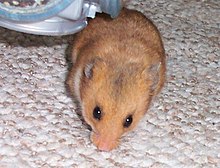| Mesocricetus Temporal range: Early Pliocene - Recent | |
|---|---|

| |
| Mesocricetus auratus | |
| Scientific classification | |
| Domain: | Eukaryota |
| Kingdom: | Animalia |
| Phylum: | Chordata |
| Class: | Mammalia |
| Order: | Rodentia |
| Family: | Cricetidae |
| Subfamily: | Cricetinae |
| Genus: | Mesocricetus Nehring, 1894 |
| Type species | |
| Cricetus nigricans Brandt, 1832 (= Cricetus raddei Nehring, 1894) | |
| Species | |
|
Mesocricetus auratus | |
Mesocricetus is a genus of Old World hamsters, including the Syrian or golden hamster, the first hamster to be introduced as a domestic pet, and still the most popular species of hamster for that purpose.
Recent research has shown that, unlike almost all other land mammals studied, all species of this genus lack the capacity for color vision.
Species
- Mesocricetus auratus: Golden hamster or Syrian hamster
- Mesocricetus brandti: Turkish hamster or Brandt's hamster
- Mesocricetus newtoni: Romanian hamster or Dobrudja hamster
- Mesocricetus raddei: Ciscaucasian hamster
Notes
- Wilson, D. E.; Reeder, D. M., eds. (2005). Mammal Species of the World: A Taxonomic and Geographic Reference (3rd ed.). Johns Hopkins University Press. ISBN 978-0-8018-8221-0. OCLC 62265494.
- Williams, Gary A. (2008). "Absence of functional short-wavelength sensitive cone pigments in hamsters (Mesocricetus)". Journal of Comparative Physiology A. 194: 429–439. doi:10.1007/s00359-008-0316-4.
References
- http://www.funet.fi/pub/sci/bio/life/mammalia/rodentia/cricetidae/mesocricetus/
- Williams, G. A.; Jacobs, G. H. (2008). "Absence of functional short-wavelength sensitive cone pigments in hamsters (Mesocricetus)". Journal of Comparative Physiology A. doi:10.1007/s00359-008-0316-4.
| Species of hamsters (subfamily Cricetinae) | |
|---|---|
| |
| Allocricetulus | |
| Cansumys | |
| Cricetulus | |
| Cricetus | |
| Mesocricetus | |
| Nothocricetulus | |
| Phodopus | |
| Tscherskia | |
| Urocricetus | |
| Taxon identifiers | |
|---|---|
| Mesocricetus |
|
This Cricetidae article is a stub. You can help Misplaced Pages by expanding it. |







